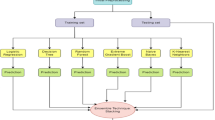Abstract
Cardiovascular illness is one of the prime sources for the loss of many human lives every year. The prime cause for mortality is the absence of past diagnostic information. Hence, for better prediction of the disease, many researchers have proposed this reason allows the researchers to build new and optimized machine learning models for betterment in prediction accuracy of such diseases with low false-negative rate. Here, a voting method is applied which uses Logistic Regression, Random Forest, XGBoost, and Naive Bayes to predict the nature of heart conditions. The system is trained, tested, and evaluated based on accuracy, precision, F1 score, Recall, and AUC. Testing witnessed an accuracy of 78%. The results show that ensemble modeling is more accurate when compared to individual models.
Access this chapter
Tax calculation will be finalised at checkout
Purchases are for personal use only
Similar content being viewed by others
References
Retrieved from http://www.clinicalevidence.com/ceweb/conditions/dia/0601/0601_background.jsp
Retrieved from http://www.fauxpress.com/kimball/med/heart/h2/bloodpres.htm
Kendrick M (2007) Should women be offered cholesterol-lowering drugs to prevent cardiovascular disease? No. BMJ 334(7601)983
Roger VL, Go AS, Lloyd-Jones DM, Benjamin EJ, Berry JD, Borden WB, Bravata DM, Dai S, Ford ES, Fox CS, Fullerton HJ, Gillespie C, Hailpern SM, Heit JA, Howard VJ, Kissela BM, Kittner SJ, Lackland DT, Lichtman JH, Lisabeth LD, Makuc DM, Marcus GM, Marelli A, Matchar DB, Moy CS, Mozaffarian D, Mussolino ME, Nichol G, Paynter NP, Soliman EZ, Sorlie PD, Sotoodehnia N, Turan TN, Virani SS, Wong ND, Woo D, Turner MB, American Heart Association Statistics Committee and Stroke Statistics Subcommittee (2012) Heart disease and stroke statistics–2012 update: a report from the American Heart Association.Circulation. 125:e2–e220
Haq AU, Li JP, Memon MH, Nazir S, Sun R (2018) A hybrid intelligent system framework for the prediction of heart disease using machine learning algorithms. Mob Inf Syst 2018(3860146):1–21
Krishnan JS, Geetha S (2019) Forecast of heart disease using machine learning algorithms. In: First international conference on innovations in information and communication technology
Dinesh KG, Garaj KA, Santhosh KD, Meswari V (2018) Forecast of cardiovascular disease utilizing machine learning algorithms. In: 2018 International conference on current trends towards converging technologies
Golande A, Kumar TP (2019) Coronary illness prediction using effective machine learning techniques. Int J Recent Technol Eng 8(1S4). ISSN: 2277–3878
Srivenkatesh M (2020) Prediction of cardiovascular disease using machine learning algorithnms. Int J Eng Adv Technol (IJEAT) 9(3):2404–2414. ISSN: 2249-8958 (Online). Published by Blue Eyes Intelligence Engineering & Sciences Publication. Retrieval Number: B3986129219/2020©BEIESP. https://doi.org/10.35940/ijeat.B3986.029320
Swain D, Pani SK, Swain D (2019) An efficient system for the prediction of coronary artery disease using dense neural network with hyper parameter tuning. Int J Innov Technol Explor Eng (IJITEE) 8(6S):689–695. ISSN: 2278-3075. Published by Blue Eyes Intelligence Engineering & Sciences Publication. Retrieval Number: F61520486S19\19©BEIESP
Retrieved from https://www.kaggle.com/bhadaneeraj/cardio-vascular-disease-detection
Swain D, Pani SK, Swain D (2018) A metaphoric investigation on prediction of heart disease using machine learning. In: 2018 International conference on advanced computation and telecommunication (ICACAT). IEEE, pp 1–6. https://doi.org/10.1109/ICACAT.2018.8933603
Author information
Authors and Affiliations
Corresponding author
Editor information
Editors and Affiliations
Rights and permissions
Copyright information
© 2023 The Author(s), under exclusive license to Springer Nature Singapore Pte Ltd.
About this paper
Cite this paper
Swain, D., Kava, M., Jadhav, R., Satapathy, S. (2023). A Novel Approach to Predicting the Cardiovascular Sickness. In: Chakraborty, B., Biswas, A., Chakrabarti, A. (eds) Advances in Data Science and Computing Technologies. ADSC 2022. Lecture Notes in Electrical Engineering, vol 1056. Springer, Singapore. https://doi.org/10.1007/978-981-99-3656-4_4
Download citation
DOI: https://doi.org/10.1007/978-981-99-3656-4_4
Published:
Publisher Name: Springer, Singapore
Print ISBN: 978-981-99-3655-7
Online ISBN: 978-981-99-3656-4
eBook Packages: Intelligent Technologies and RoboticsIntelligent Technologies and Robotics (R0)




